Mary Ellen Cahoon 1870 - 1952
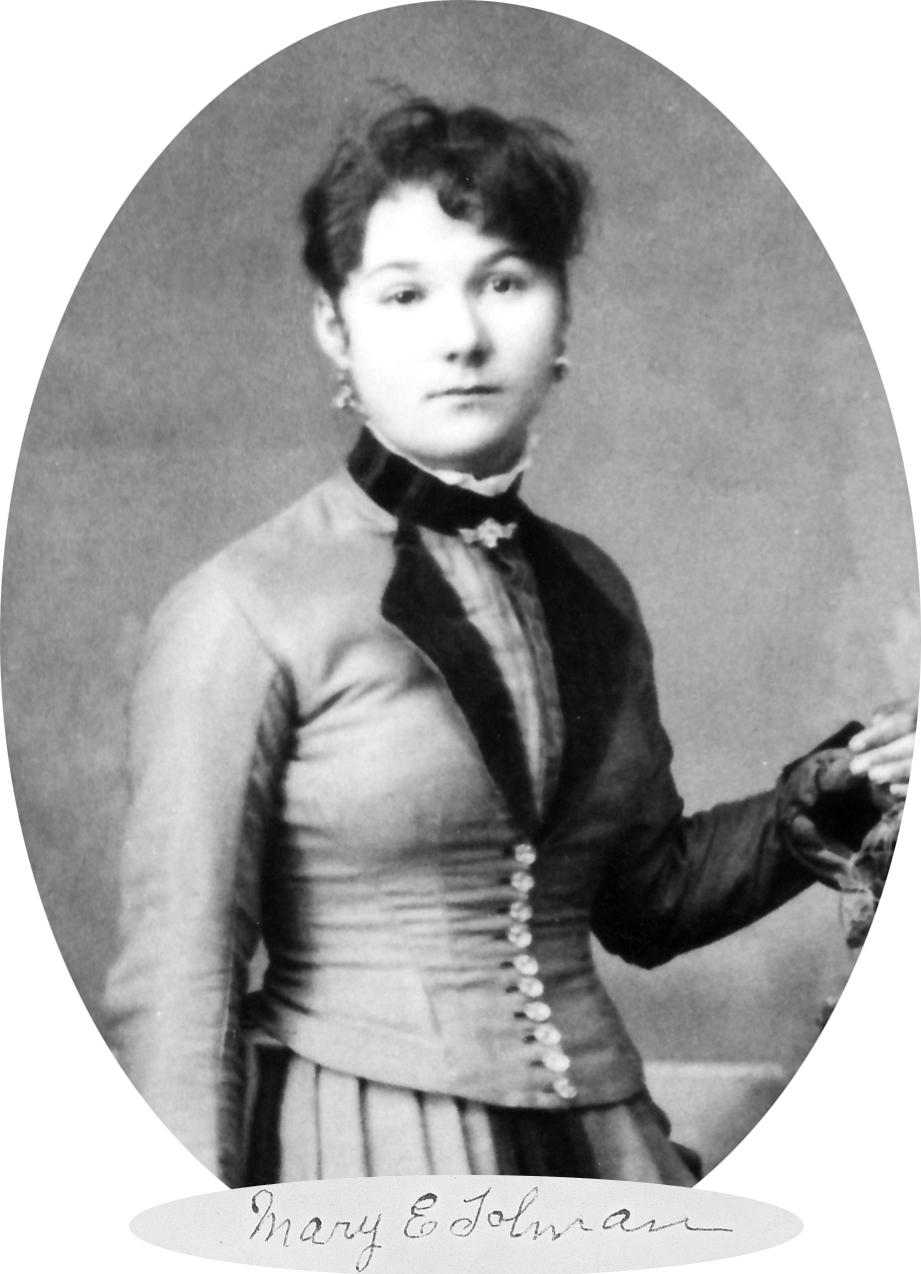
Links for Mary Ellen Cahoon
Histories
History
From the History of Joseph Holbrook Tolman and Mary Ellen Cahoon, page 3:
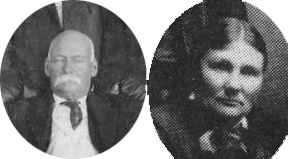
Rais Bell Cahoon and Mary Charlotte Johnson
Since her mother's first name was also Mary and because of the references to her as "Aunt Ellie, or Aunt Ell" later on in Aunt Lavaughn's histories and in a note by her daughter Isolene where she refers to her as Ella Tolman, and in a listing of Relief Society Sisters in Inkom, Idaho in 1913 she is listed as Ellen Tolman and in 1916 as Ella Tolman, I am assuming she was called by her name Ellen or variations of it - Ellie, Ella when she was little and then later as an adult. In this history I'm going to use either Mary Ellen or Ella.
On October 30, 1874, a couple days before her 4th birthday, Mary Ellen received her Patriarchal Blessing from John Smith, the fifth Presiding Patriarch of the Church of Jesus Christ of Latter-day Saints.
From the History of Joseph Holbrook Tolman and Mary Ellen Cahoon, page 3:
Mother lived in Brigham City until 1881, then moved to Gentile Valley, Idaho with her parents, brothers and sisters. Here they homesteaded and raised their family. They had six children born at Brigham city, Box Elder County; and five children were born in Mound Valley, Bannock County Idaho. She said a small log house was used for school and church meetings.
She (Mother) received very little schooling, as soon as she was able and old enough to work, she would go out and work, the hours were long and hard, and small pay, fifty cents a week. She would give her parents the money to help out. She and her sisters helped their mother cord wool into rolls, then spin into yarn, then knit into stockings, mittens, also quilt bats. She (Mother) said the winters were long and cold. But they enjoyed coasting down hills in home-made sleighs. They had to make their entertainment, but she felt they were happier than the children of today.

Mary Ellen Cahoon 1880 Census - age 8 (
Entire page
)
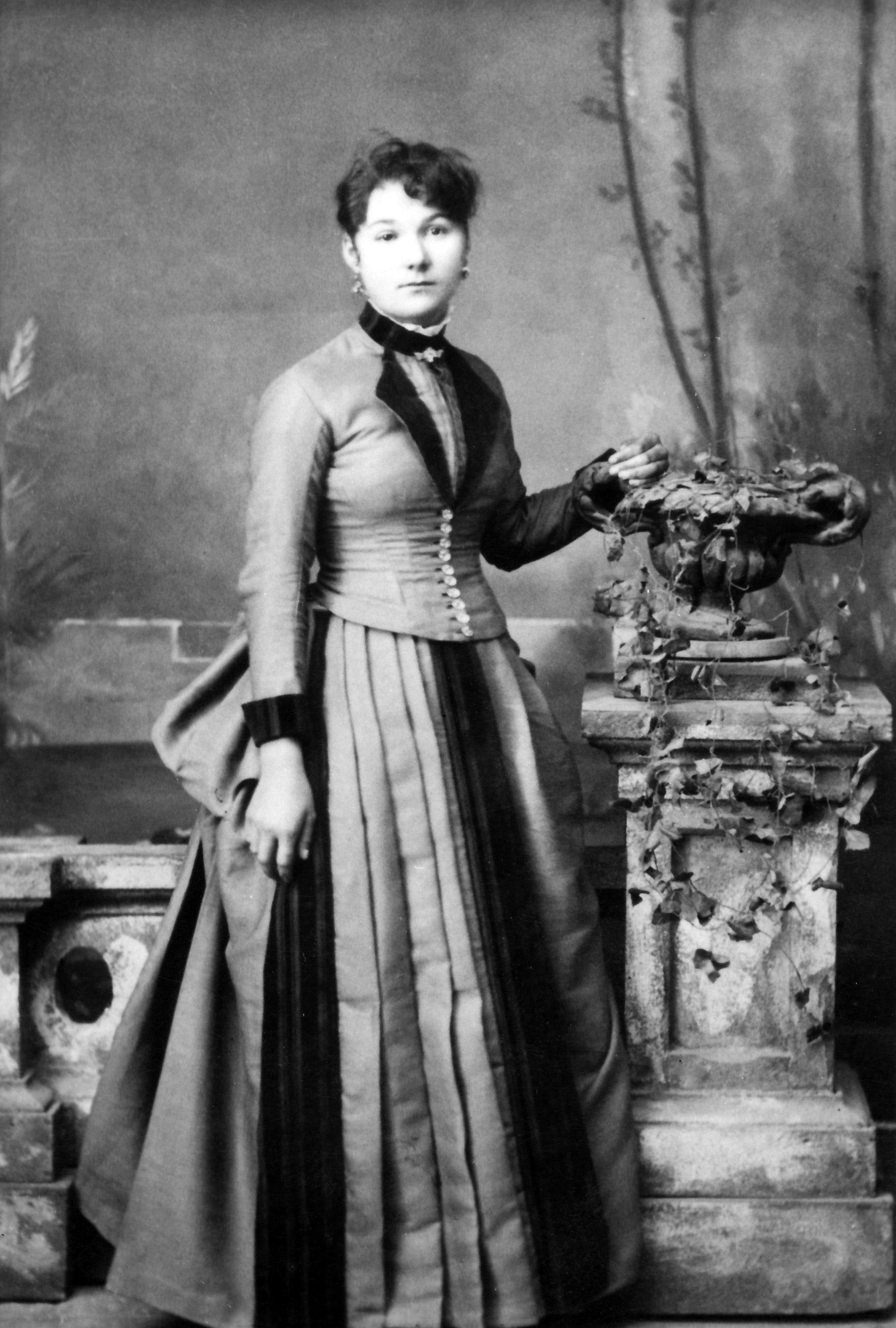
Mary Ellen Cahoon Wedding Picture
From a letter written to her daughter Lavaughn December 25, 1941. Found in the History of Joseph Holbrook Tolman and Mary Ellen Cahoon, starting on page 4:
On November 17th; 1887 I married Joseph Holbrook Tolman in the L.D.S. Logan Temple. I went into plural marriage. I saw many very trying times, but I never forgot the Blessing I received. Sometimes when I was tried with what I thought almost more than I could stand, that peaceful feeling would come over me and I would feel to say “Thank YOU Dear Lord” for that lovely feeling and I would get courage to go on.
“I want to bear my testimony to my dear Children, I know the Gospel is true, and the Lord won’t fail us if we do our part, Amen.”
Three years after my marriage the “Manifesto” was declared. At the General conference of the Church, October 6th, 1890 the manifesto was presented to the saints assembled there and was unanimously adopted.
Times were very hard and trying. I lived with relatives in Utah. Our first baby born on the 10th of July 1891 at Beaver Dam, Box Elder Co., Utah. On July the 29th, 1891 he was taken back to our Heavenly Father.
On the third of May 1893 a beautiful daughter Della May was given to me to love and care for. She was born at Honeyville Utah, Box Elder Co.
In June 1896 I moved from Honeyville Utah to Chesterfield Idaho, Bannock County. On June the 29th 1896 again I was blessed with a son Alvin Henry.
From the "History of the "Loveland/Simons" House" which is the "little yellow house" that Joseph Holbrook built in Chesterfield, Idaho:
On November 17, 1887, Joseph Holbrook Tolman married a second wife, Mary Ellen Cahoon. She did not move to Chesterfield until June 1896 with two living children who were born in Utah. The first child Judson Reynolds, lived 13 days in 1891. When Mary Ellen came to Chesterfield, she stayed with Joseph's uncle and aunt Judson and Mary Tolman who lived west and across the street from the "Little Yellow House".

Mary Ellen Cahoon 1900 Census (
Entire page
)
A note about Mary Ellen's record in the 1900 Census. I had a difficult time finding her in this census and only did so through the names of her children. In this census she is listed as Ella M. with the M. presumably for Mary. The other issue making finding her difficult was the transcribed record of the census listed her last name as Talman not Tolman. Looking at the record you can see why the transcriber would spell it Talman.
From a letter written to her daughter Lavaughn December 25, 1941. Found in the History of Joseph Holbrook Tolman and Mary Ellen Cahoon, starting on page 4:
On February 7th, 1902 another son Joseph Leroy came to spread joy to us. He was born at Uncle Ad’s and Aunt Mary Ann’s home in Chesterfield, Bannock County, Idaho.
On the 26th of August 1904 another son was given to me to love, Lealand Napoleon, but in a very short time he was taken very ill and while alone with my small children, he was taken to his Heavenly Home. He was born in my very own little home (The "Little Yellow House"), oh, no one can imagine the joy that went through me as I stepped into my first little home, of my very own.
On June 25th, 1906 I was blessed again with a sweet little daughter, the name being Lavaughn.
From the "History of the "Loveland/Simons" House" which is the "little yellow house" that Joseph Holbrook built in Chesterfield, Idaho:
Mary Ellen's foruth child, Joseph Leroy Tolman was born in the Judson Tolman home on February 7, 1902.
It was about 1903 and definitely in the year of 1904 that Mary Ellen occupied the "little Yellow House".
From the History of Joseph Holbrook Tolman and Mary Ellen Cahoon, starting on page 4:
In August (1904) Mother’s cousin Parley Jensen had sorrow heaped upon him. His dear wife passed away shortly after giving birth to a lovely daughter. The wee one was taken by grand parents and others, to try and keep her alive. It was hard to find anything to agree with this wee baby. One day Cousin Parley came with tears flowing down his cheeks. Oh, Aunt Ellie, my baby is dying. Mother left her baby Lavaughn with Della May and hurried away with Cousin Parley to his mother-in-laws home. Sure enough the baby was as gone as ever could be and still have a spark of life in that little body. Mother bundled the baby up and rushed home. She undressed and climbed into bed, cuddled the infant close to her body. Then taking a spoon and eye dropper proceeded to feed her. Mother said after three or four hours she felt a little quiver, and a little later she felt a slight movement. She continued this treatment for several days, soon the baby could nurse and became a beautiful chubby girl “twin for Lavaughn”, Mother said. Surely Lavaughn never went hungry, she would hold each at feeding time, and enjoyed watching their cute maneuvers. Mother cared for and loved this little girl until she was nearly four years old. Then her father re-married and came to get the “little girl Minnie.” Mother often said this loss was as great as if she had been her very own. On Mothers 79th or 80th birthday we children gave mother a big dinner at (Ross and Lavaughn’s) home and surprised her with the presence of her precious ‘Minnie’. She came from Salt Lake City to celebrate with us. This was a great day and evening for all of us.
All the years while living at Chesterfield, times were very hard and she saw little of our father. She worked very hard for friends and others, doing house work, nursing, tending children. She did seamstress work all over the valley. Sometimes in her own home and again in the homes of others, sometimes she would take the children and stay for weeks, doing sewing for all members of this family.
Father built a saw-mill at Dempsey Idaho, south and east of Lava Hot Springs, Idaho. In October we moved to a small house there. On November 4th, 1908 we were blessed with a baby, a sweet little girl “Leona”. When she was born I suffered death many times. The mid-wife could not deliver her and finally they got Doctor Kackley from Soda Springs. By that time my life was about spent, after delivery, the Dr. left me in a sad condition, he told my ‘father’ she will soon be gone and suffer no more. But I sadly fooled them, but from that time on she suffered, well no one will ever know.

Mary Ellen Cahoon 1910 Census (
Entire page
)
From the History of Joseph Holbrook Tolman and Mary Ellen Cahoon, starting on page 4:
On April 19th, 1912 again a wee wee baby (Idona Isolene) came to delight our home. A midwife by the name of Mrs Toones delivered her. The baby was three months premature and oh so very small, she could not be handled as a normal child. (Lavaughn) well remembers the crib or incubator which Mrs Toones provided for her. They used an old rocking chair. She used rocks under the pillows, which had been heated in the oven. She used cotton batting to nest the baby in. We kept rocks heating in the oven all the time, as the ones being used cooled off, they would be replaced with hot ones. Mrs. Toones would milk milk from mother into a spoon, use an eye dropper to feed the wee one. She was changed and rubbed with oil, without removing her from the nest. Soon she started gaining strength, and was removed from the nest into her mothers arm and bed. She was a miracle baby. Mother said Mrs Toones judged her weight as about two pounds.
My first impression of her was a little skinned rabbit. When she was about three months old mother said she could put her in a gallon crock and put the lid on and a teacup would set over her head and down to her shoulders. But with such perfect care and rich milk she started to be a darling little black haired doll.
In the fall of 1911 father purchased ten acres of land from George A. Whitworth, in Inkom, Idaho. He also purchased a right-of-way through his farm to build and maintain a ditch to carry water to a sight selected for a water powered saw mill. Some work was done that fall. Then in the spring of 1912 father took his two young sons Alvin and Joseph Leroy (known as Roy) with him to Inkom from Lava Hot Springs to build theshop, ditch, and mill pond. By fall the shop and a one room house was built.
In September of 1912 he moved his family, Mary Ellen his wife, daughters Lavaughn, Leona and Idonna Isolene to the new home. The house had one large room to sleep a family of seven. So the boys slept down in the shop, father fixed boards on top of the ceiling joists, made a ladder up one wall for us to climb up, and this is where we girls slept, our beds on the floor.
In November Alvin became very sick, he had a high fever and in much pain. The fever made him very thirsty, he drank up all the water which had been provided the night before, he kept begging for a drink of water. Mother could no longer stand the pleading for a drink, she took a pail and lantern and went to get him water. It was a very wild, rainy night, and high wind. She climbed the hill back of the shop, then reached down into the flume filled the pail, raised up, then reached down to pick up the lantern and the wind blew it out. Losing her footing in the total darkness, she fell over a steep bank into the rocks, gravel and mud. She found that her leg was broken at the ankle, the bones were filled with gravel and mud, as was the flesh. It was some distance down the steep hill to the shop. She crawled on her back dragging the broken limb, to the shop door. She called to her sick son Alvin to go to the house for help. This he did. Mother never saw her son Alvin again, after he ran past her to get father. That night of November 11th, 1912 Alvin passed away, grieved and broken hearted, to think he couldn’t wait a little longer for a drink.
In those days help, Doctors and transportation were hard to come by. T. I. Richardson was about the only one with a telephone. They called Dr. Wooley or Steeley, who was unable to come, and sent Dr. A. M. Newton. When he looked at the broken leg he knew there was nothing he could do in the home, and that she must go to the hospital.
The bone had run into the rocks, gravel and mud about six inches, by the time the doctor came from Pocatello, the bone and flesh had dried out. Dr. Newton gave her a shot for the pain and said as soon as he could get into Pocatello he would make arrangements to get her into the hospital. He made arrangements with the railroad officials to have a through train stop at Inkom Depot and pick her up.
A bed was made on a cot, Mother was placed gently on it. She was placed into a wagon box. By the time they got her to the depot it was late afternoon. The train came, sped by without stopping, leaving the injured sufferer. Mother was then taken to T. I. Richardson’s they took her into their home, in a short time a call came saying the railroad was sending a special train to get her. The train was backed the twelve miles from Pocatello. After the scorching the Doctor gave the officials they were glad to do anythingto right their mistake. By the time mother arrived at the hospital it was near midnight.
Doctor Newton told father since there had been so many hours lapse since the break, the only thing that could be done was to amputate the leg. Father would not consent to this, so the only thing they could do was clean the flesh and bones, after a fashion they set her leg, because they were so sure amputation was the only way to save her life. After many days the case was removed to see what was happening. (In these days the cast would remain in place and an xray would be taken.) Finding that the leg had started to knit, or mend, without infection, it was necessary to rebrake the bones, and reset the leg.
Of course father and others knew why the leg was doing so well. The Lord had heard and answered the many special blessings pronounced upon her head and the faith and prayers which were exercised daily in her behalf.
Mother mended satisfactorily and was taken to her daughter Della and Ernests home. Here she remained, with love and special care, until spring, of 1913. Della and Ernest had loved and cared for Isolene, until such a time as mother could care for her and the family. Mother in going home was on crutches and it was hard for her to get around. But Della was expecting her first child and no longer could carry the responsibilities.
Joseph Leroy remained at home with father, while Lavaughn and Leona stayed with their grandmother Cahoon (Mary Charlotte Johnson) It was a great thrill when the time came for we girls to be going home to mother and father and our dear brother and little baby sister.
Mother had a slight limp, but a mighty good leg. Dr. Newton was real proud of the job; it was one of the first experiences he had with broken bones. He often mentioned it, and commented on how fortunate she was in having a leg. He said it had always been a mystery to him, why gangrene had not developed and her lose the limb. We all know why. We have always given Thanks to Our Heavenly father for a living testimony of His goodness and mercy.
The folks in about 1914 started a berry farm and nice orchard. They had several acres of raspberries and strawberries. Mother and the girls worked very hard, to keep them pruned and cleaned. Then there was the watering and picking. There were a number of our neighbor women who came for years and picked berries for berries. There were four Indian women who came and picked also. They camped on the mill yard, through the berry season. In the fall at choke cherry time they would return. I shall never forget one morning real early old Joe Jackson came to the house, blood running every where. He had been fixing a fence and the wire broke and run through his hand. The barbs really tore his hand up badly. Mother hurried and tore up a sheet and laid it in the oven to sterilize them for bandages. Mother was almost afraid to pour turpentine over the wounds or iodine which were about all the disinfectants she had. She warned him this would hurt very bad, but he didn’t care. Just make better, she poured the iodine over it, and oh the capers the poor man went through. Mother then bandaged it up, and told him to come back in a few days to get it redressed. The next morning he was back, mother thought maybe she best not to use the iodine, but he said, “No, Whoopie medicine” so she poured some on the wounds, again the capers began. Each morning for weeks he was back, until it was healed.
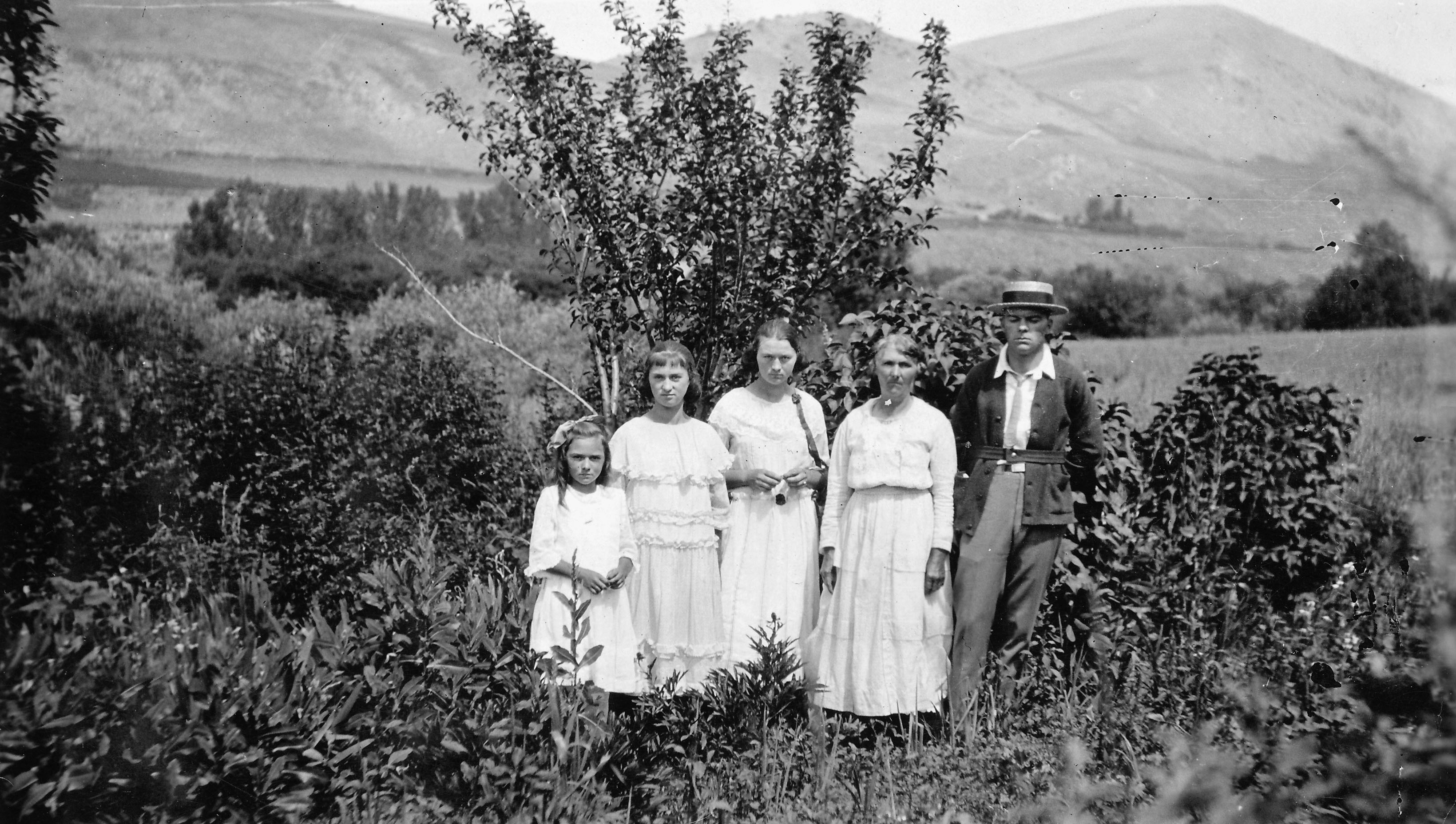
Isolene, Leona, Lavaughn, Mary Ellen, Joe
At the berry farm
Listen to this audio (recorded June 2015) as Verlene (Isolene's daughter-in-law) describes how Isolene, her mother and sisters worked hard and and then their father would come and take the money they earned for his other wife's family.
From the History of Joseph Holbrook Tolman and Mary Ellen Cahoon, starting on page 4:
Mother being a Relief Society worker, had lots of trips to make here and there, so father decided mother must learn to drive the car. So proudly one Sunday morning, all dressed in our finest clothes and headed to Sunday School. All was going well, when father said turn right here and stop. She stopped alright, instead of her foot on the brake it pushed the gas peddle. She took the front porch off the Church House. Father said, “Well they were pretty rickety anyhow and needed fixing. The next day he hauled lumber to the site when the new steps and porch was finished, they were as solid as the Rock of Gibraltar. They were as solid in 1931 when the church house was remodeled, as when built. Mothers car driving days were over that very day. She would never touch the wheel again.
During World War I mother was a counselor in Relief Society. They knit mittens, sox, sweaters, and scarfs for the Red Cross, also tore and wrapped bandages. Then came the great flu epidemic (in 1918). Oh such sickness every where, and deaths. Mother and other women were on the go day and night, from one place to another, trying to relieve the sick and suffering. Then came our turn. The Lord had been so good to us. I (Lavaughn) took it first. One night I started coughing along with a high fever. Mother said, something happened, blood shot from my mouth, nose and ears. She said there was hardly a spot in the room which wasn’t covered with blood. She got Roy (JOE) up and sent him for Bishop Webb. Father was not home, he was in Pocatello with Aunt Dellie, his first wife. The Bishop and sister Webb came. Bishop Webb administered to me, mother said soon the bleeding stopped and I quieted down. They stayed the rest of the night with mother. Bishop Webb blessed mother and promised her through her faithfulness all would be well. That she would be able to labor and help others in need. Other members of the family had it but in a lighter form. Soon mother was back helping others in need of her services, which she did all through the epidemic. Well she helped people all her lifetime. In this she found great joy and happiness.
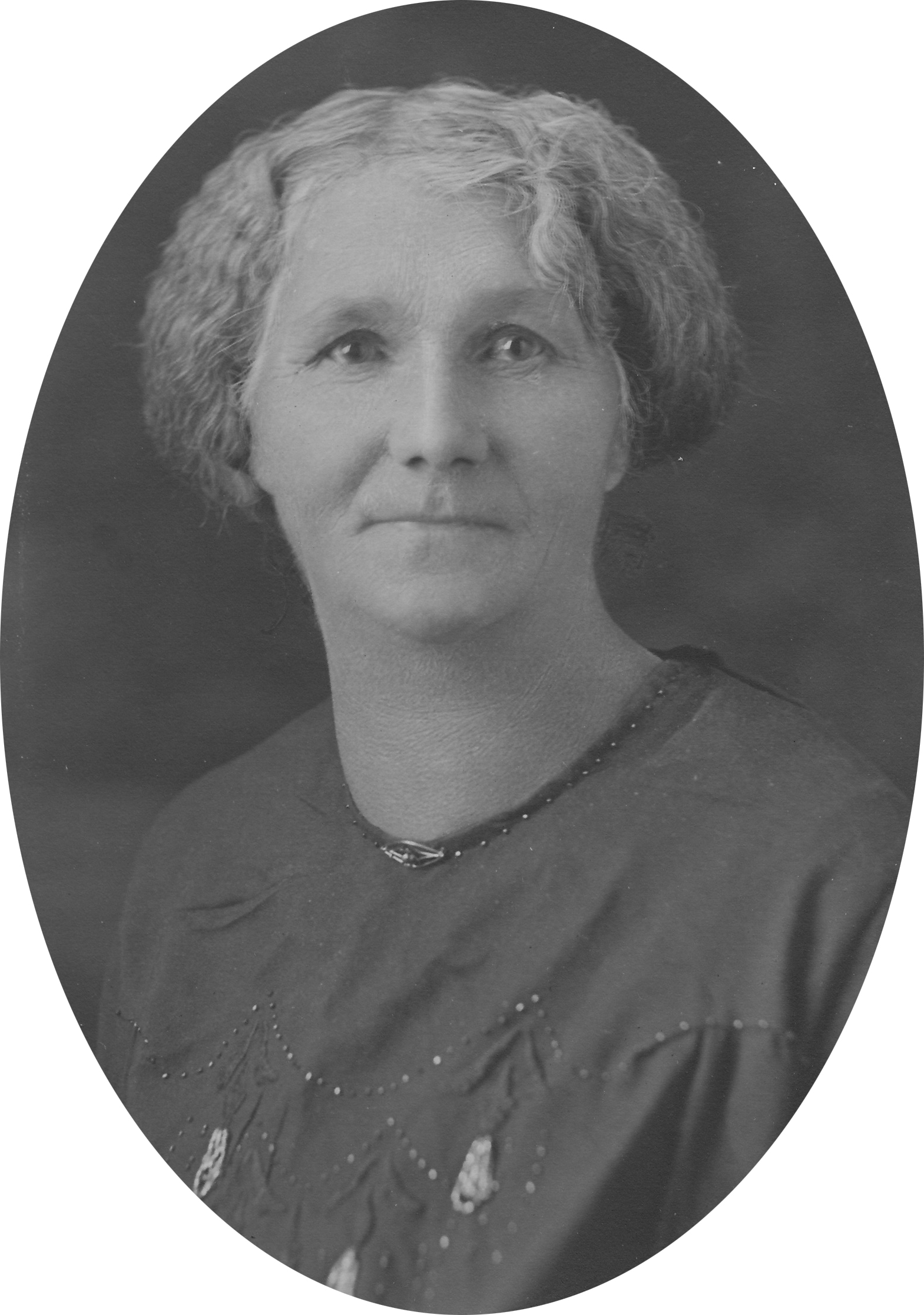
Mary Ellen Cahoon

Mary Ellen Cahoon 1920 Census (
Entire page
)
From the History of Joseph Holbrook Tolman and Mary Ellen Cahoon, starting on page 4:
In the year of 1921 mother was sustained president of the Relief Society. She served until summer of 1924. She loved the Relief Society and served the Lord, and saints well.
On March 4th, 1924 Joseph Leroy, taking mother and a lovely young lady went to Logan, Utah, where the following day they went up to the House of the Lord, where Joseph Leroy and Leona Ellenor were married for Time and Eternity. Mother was filled with pride and joy to have seen this dream come true, her only living son married in The House of the Lord.
In about 1926 father traded the home place to Doctor A.M. Newton for a piece of ground about one half mile south and west of our old home place, at the forks of the roads that leads to Buckskin and Jackson creek. Here he built a five room home, a barn and chicken coop. They worked hard getting the new home completed, a new berry patch and orchard going. The summer of 1928 mother got a gooseberry briar in her left forefinger, and soon blood poisoning set in. Mother came near loosing her life. The Doctors tried hard to cure it. Finally due to so much infection, and for so long, the bone started to decay, the finger had to be taken off at the hand joint. Mother had a way of making the best of her hardships. She continued to knit lace, mittens, gloves and sweaters. She crocheted yards of lace, aprons, hot pads and did all sorts of hand work.

Mary Ellen Cahoon 1930 Census (
Entire page
)
From the History of Joseph Holbrook Tolman and Mary Ellen Cahoon, starting on page 4:
In the spring of 1931 the Anderson Lumber Company fore-closed on the home, it left my parents with about one hundred dollars. Della and Ernest gave them a place to build a small house on their ranch in Lava Hot Springs, Idaho. Brother Lamoni (a half brother) hired a truck from Bistlines Lumber Co, where he worked, and moved their possessions up to Lava. All the in-laws Joe, and brother Lamoni turned out one morning and by night had one room completed. The room was small but paid for, and mother was grateful for it. In a couple of years, one bright early morning, mother Della and Ernest saw a big truck pull up over the railroad tracks, with a house on it. Lo and behold it was dear brother Lamoni. He had built this room at home and hired a truck from Bistlines, whom he was still employed by. He then cleared a place back of the one room, cut a doorway, then backed the truck in, lowered the room and anchored it securely to the other room. It was a darling room all papered in a cheerful pattern. Della, Ernest and Lamoni moved the bed into it and other things, and helped arrange the other room. Mother was so happy. Brother Lamoni whistling happily hopped into the truck and drove away. How mother and father enjoyed this new addition. Mother cried many tears of gratitude and love for being blessed with such a sweet step-son. No, not that, for all through the years this dear brother was like a son to her. He knew and understood the many hardships mother had endured. As well as the heartaches of his own dear maother, living in plural marriage. This dear brother always called mother Aunt Ell. When his dear Mother passed away, he came to mother and said “Aunt Ell your all the mother I have now. Mother was highly honored by these kind words.
Father passed away just one month after his first wife, Aunt Dellie (1935).
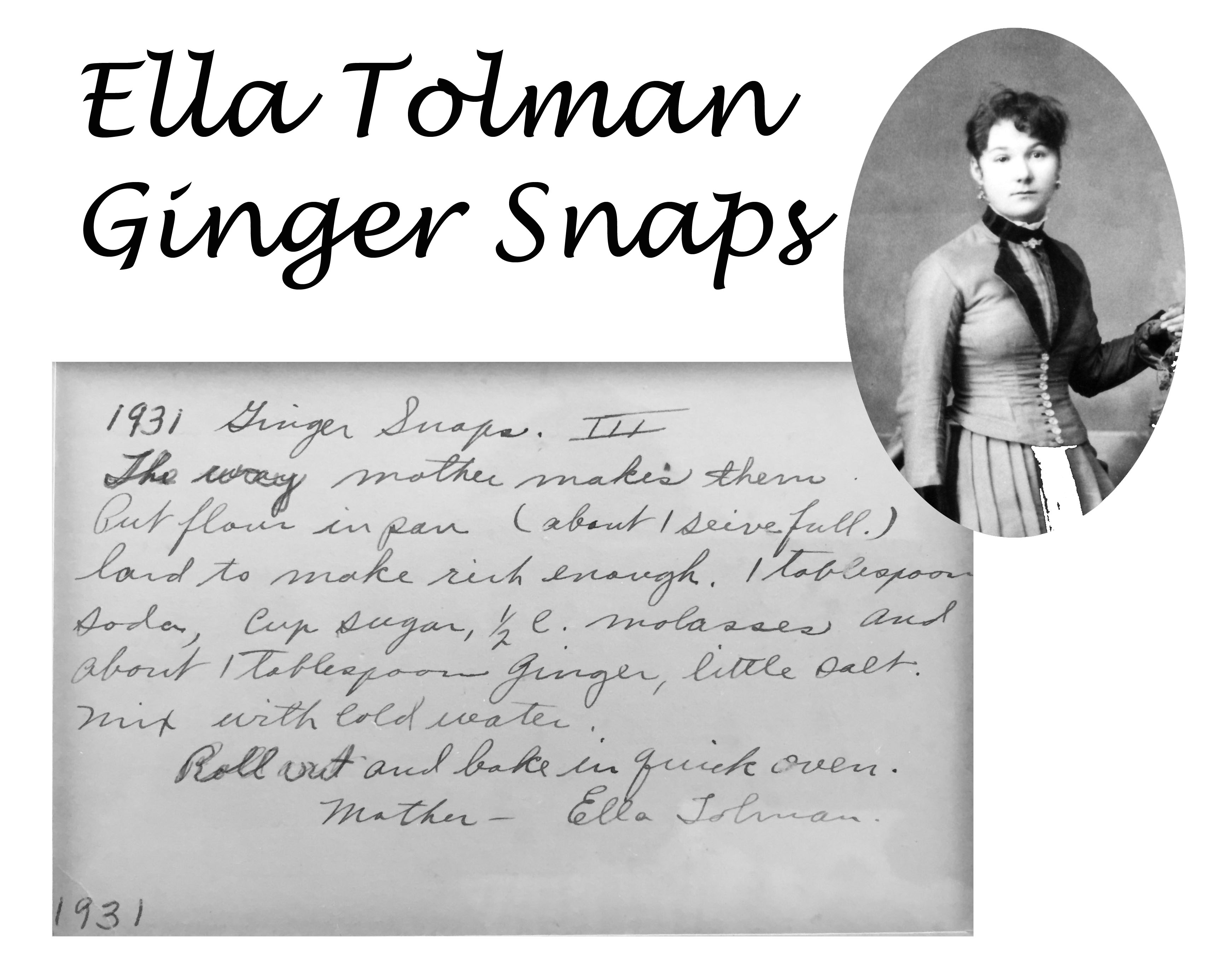
Recipe of Mary Ellen's written out by her daughter Isolene
Notice the date - 1931

Mary Ellen Cahoon 1940 Census (
Entire page
)
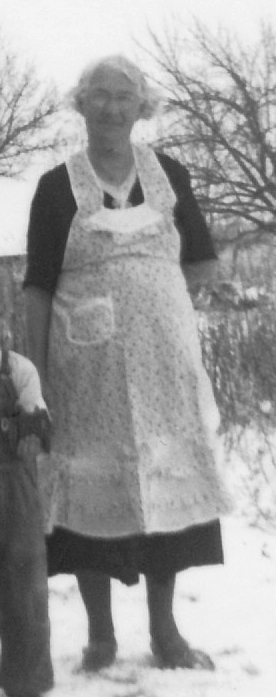
Mary Ellen Cahoon ~age 68
At daughter Isolene's farm in Wapello, Idaho
From the History of Joseph Holbrook Tolman and Mary Ellen Cahoon, starting on page 4:
Mother lived in her precious little home until 1943 or 1944. In 1942 Della and Ernest rented the farm to people by the name of Perkins. Mike Baird note: It is very likely that these Perkins are relatives of my father-in-law Ty Perkins who was raised near Soda Springs, ID. Mother finally decided she would leave the ranch and be closer to the children. Joe had returned to Pocatello, after having lived in Rupert, Jerome Idaho, then Klammoth Falls Oregon. They were living in a place or home on South 10th. There was an apartment in the basement which Joe moved mother into. When the owners of the building returned to Pocatello, Joe and family and mother moved into the Black apartments. Mr Black had a number of apartments which he rented to elderly ladies. She was so happy there, how the dear old ladies did enjoy one another. They would take turns fixing dinners and refreshments. Mother so often said, those were the happiest times of my life, except when helping my dear ones. Mother loved to bake bread and would always take Mrs Black a loaf, as others in the apartments. It gave her great pleasure in doing this.
Each of her children lived quite close by, and dropped in often, to eat with her and enjoy her sweet spirit. On her birthdays we would gather together either at her home or one of ours, and have a nice dinner. She looked forward to these events. It was hard to know what to give her that she would use, and not tuck away for us to get back someday. We all got our heads together and decided on things she likes so well, and felt she couldn’t afford. I shall never forget the first birthday we did this. We had bacon, salted peanuts, ham, salted herrings, kippered salmon, old fashioned chocolates, she did love them, she didn’t care a darn for rich chocolates. Isolene brought squash, a dressed chicken, potatoes, carrots, onions, fresh apples, and a big birthday cake she had baked. We had sandwiches, salad, ice cream and cake. We ate only part of the cake and the next day mother had a party of her own. She just bubbled over with happiness.
Her health failed and she had many problems and the Doctor, said she must stay in bed. In March 1951, she said deciding to take the Drs advice was the biggest decision she ever made. To go to bed and have someone wait on her, she never wanted to happen. Joe and Leona went and stayed in her apartment for two weeks, then I would go get her and bring her to our home for three weeks. We would then take her back to her apartment, where Joe and Leona would take over for another two weeks. We repeated this program for about four months. One morning she said to Joe go see Lavaughn and Ross and see if they could stand me all the time, she felt it was asking too much of Joe and Leona to give up their home and knew their place was being neglected. Joe came and talked to us, we were delighted to get this privilege of having her, to love and try in our small way to repay her for the love and help she had given us. In August we gave up her apartment and moved her things, some to our place and the rest to Joe and Leona’s.
Joe and Leona came every other week end and took over, while we went wherever we wished. Sister Leona came often and stayed several hours while I shopped or what ever. She brought her mangle out for me to use, and I appreciated her very much. When mother got real bad Leona and Joe were here on a minutes notice. I don’t know what I would have done without them. A bond grew between us that I am sure will last through the Eternities. Della worked at Albertson’s, she and Ernest would come and stay a little while, but when you work there is so much to do on your day off. Mother really longed for her, and looked forward to her visit.
Isolene lived on a farm and farther away, also worked, she made trips very often to help and visit, she spread joy to all of us. Brother Lamoni came often, oh, yes so often and brought so much sunshine with him. This always pleased us so much and did so much good for mother
On March the 19th, 1952 about 1:30 P.M. Mother was called home, to the longed for rest from earthly pain and cares. She had for a long time wanted to go to her loved ones. She would so often say to me “don’t feel too bad when I go, as mother is old and sick, and honey I have as many or more on the other side waiting for me, as I do here.”She was laid to rest beside her husband and son, and three grand children in the Inkom cemetery, a very hallowed spot. She now has a daughter Leona resting only a few feet from her.
At age 80, in 1951, Mary Ellen wrote this in the Tolman Family Book of Remembrance and Genealogy (compiled in 1953):
I was born 3 November, 1980. Second wife of Joseph Holbrook Tolman. I was married in the Logan Temple 17 November, 1887".
I have been active in the church all my life serving as teacher in the Sunday School and Relief Society. I was Relief Society President several years. I have enjoyed all my labors in the church.
I have worked and cared for the sick and have been thankful that I had my health and was able to help some one in need. I am now eighty years old and have to depend on others to help me. My children are very good to me, they come and clean my house and care for me. My eye sight is almost gone and they are always there when ever I need help.
I've worked very hard and did all I could to support my family. I was a seamstress and did sewing for people many years, later we moved to Inkom, Idaho, and I raised berries. I no longer am able to work, I live in a nice little apartment here in Pocatello, Idaho and hope I will be able to stay here as long as I am here on this earth.
Mary Ellen's and Joseph's 8 children:
- Judson Reynolds Tolman (1891 - 1891)
- Della May Tolman (1893 - 1978)
- Alvin Henry Tolman (1896 - 1912)
- Joseph Leroy Tolman (1902 - 1976)
- Leland Napoleon Tolman (1904 - 1905)
- Lavaughn Tolman (1906 - 1991)
- Leona Tolman (1908 - 1970
- Idona Isolene Tolman (1912 - 1987)
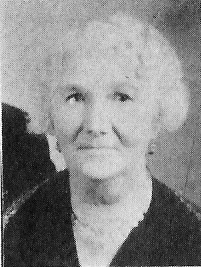
Mary Ellen Cahoon
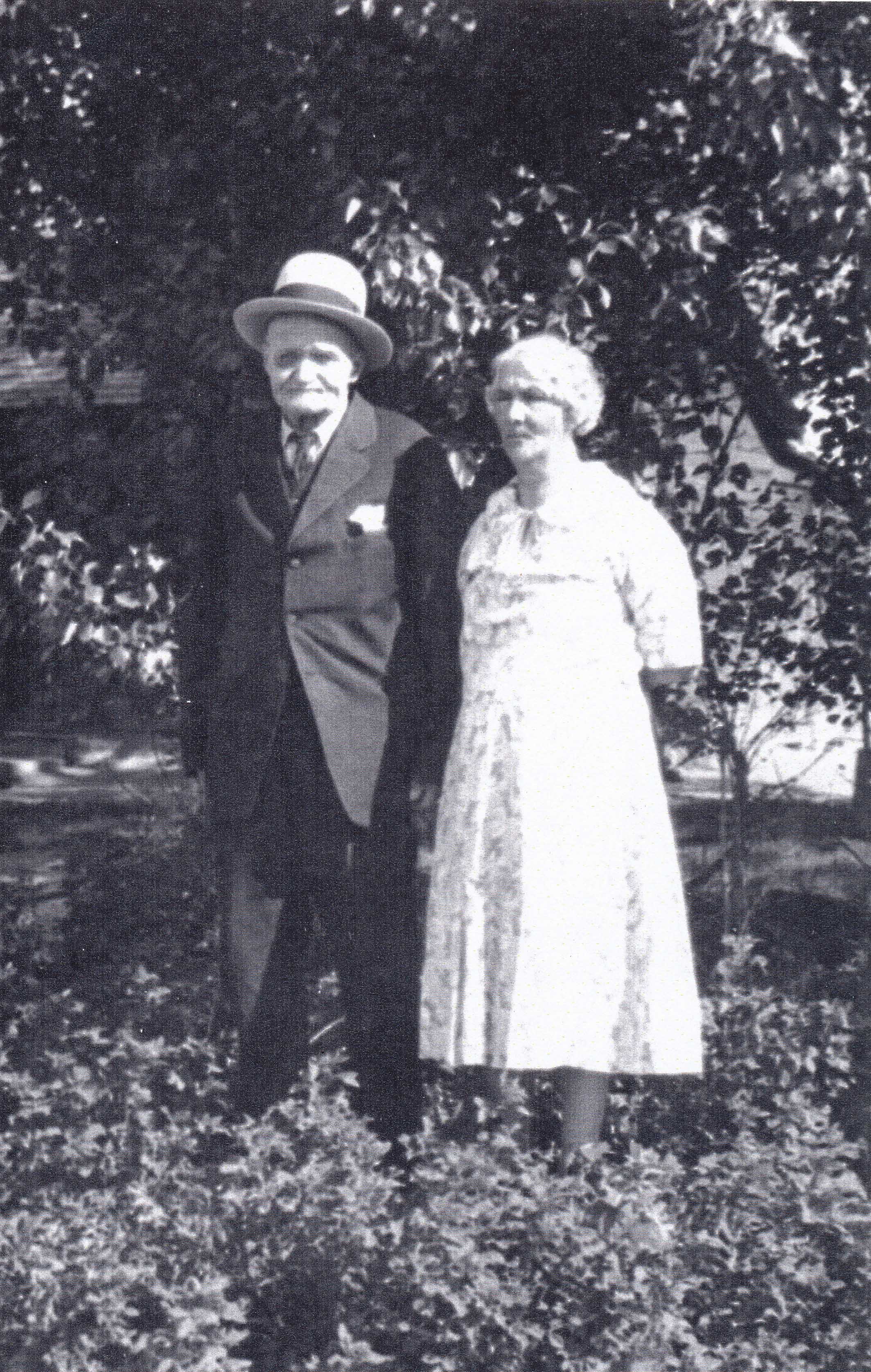
Joseph Tolman and Mary Ellen Cahoon
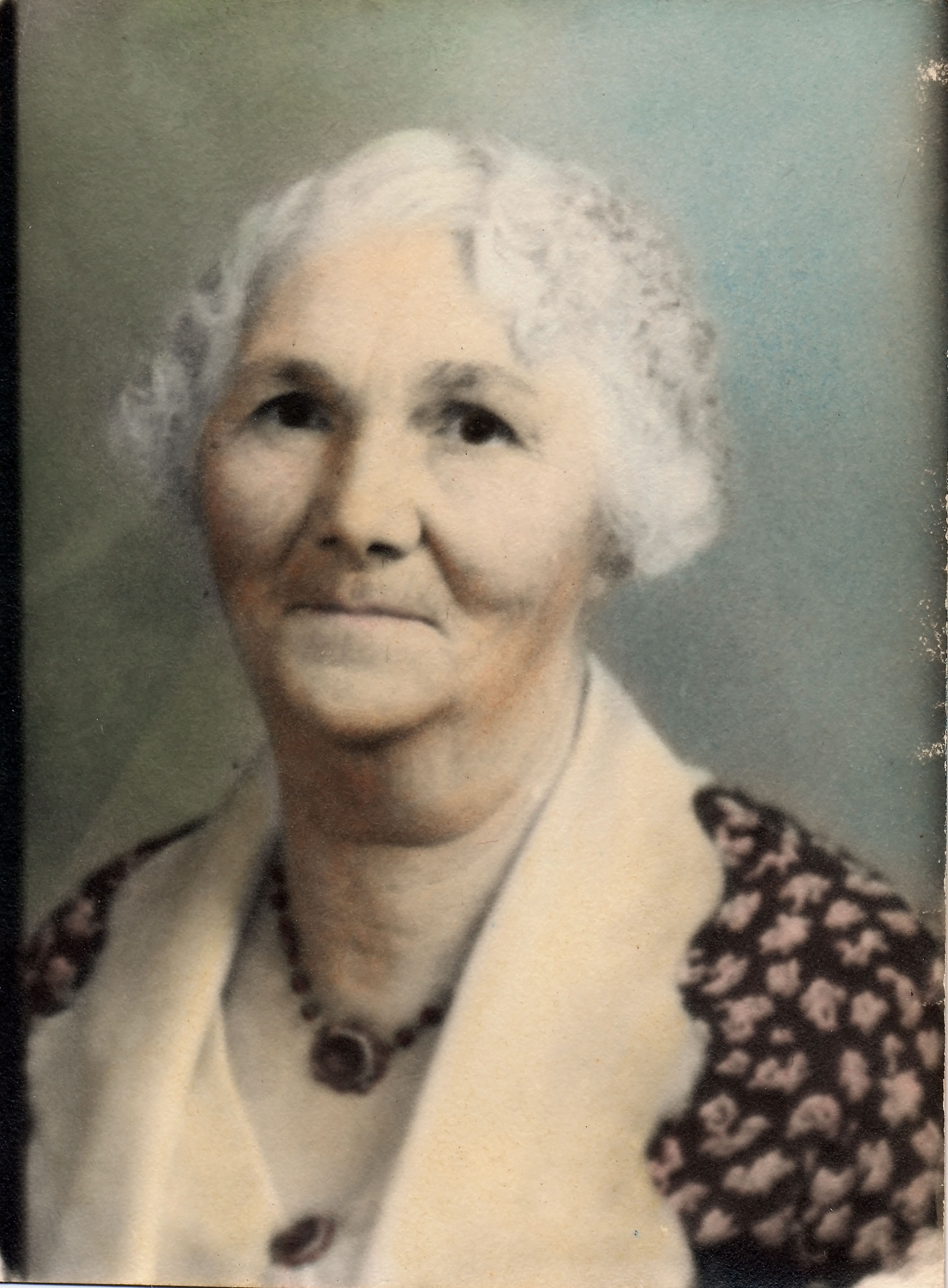
Mary Ellen Cahoon
Mary Ellen died 19 March 1952 at Inkom, Idaho at 81 years of age. She was buried 22 March 1952 at Inkom, Idaho.
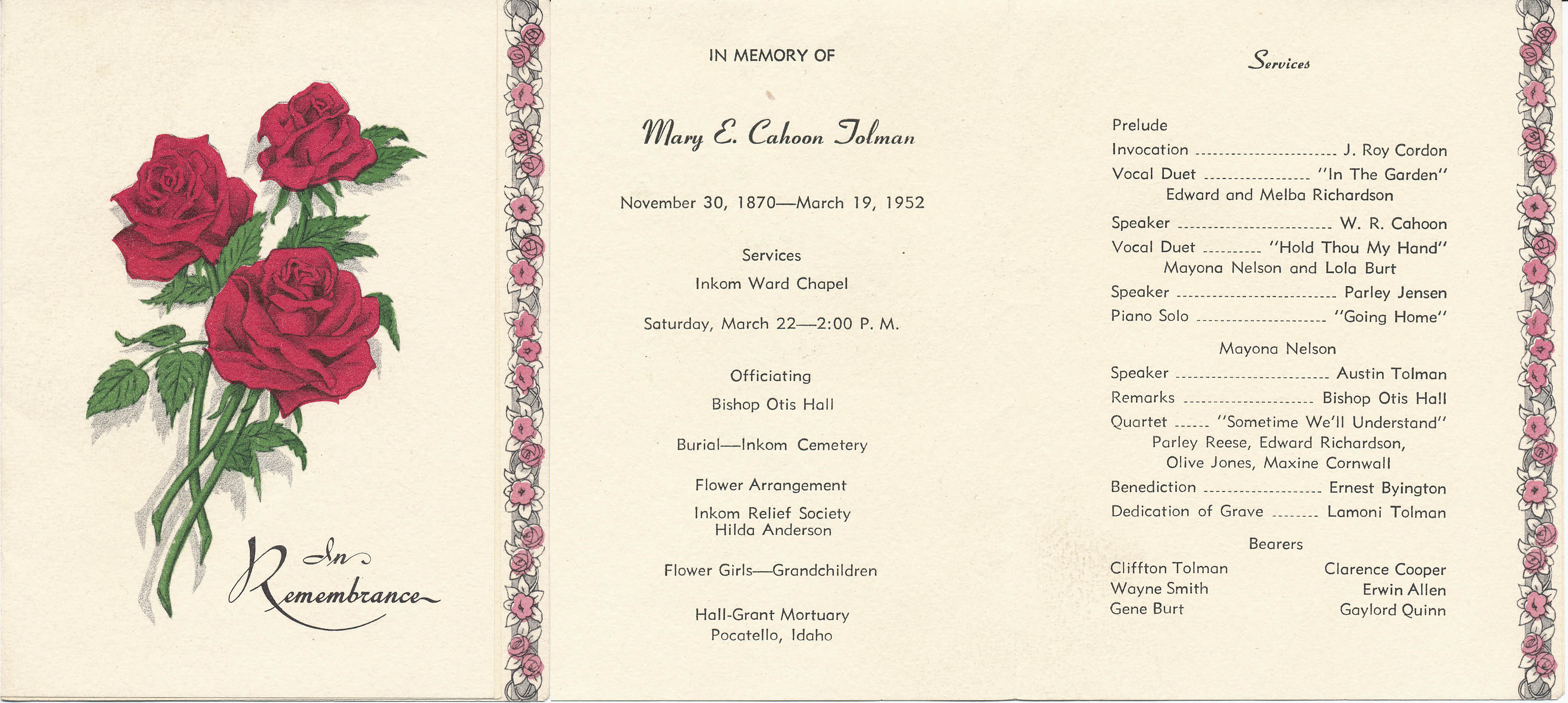
Mary Ellen Funeral Program
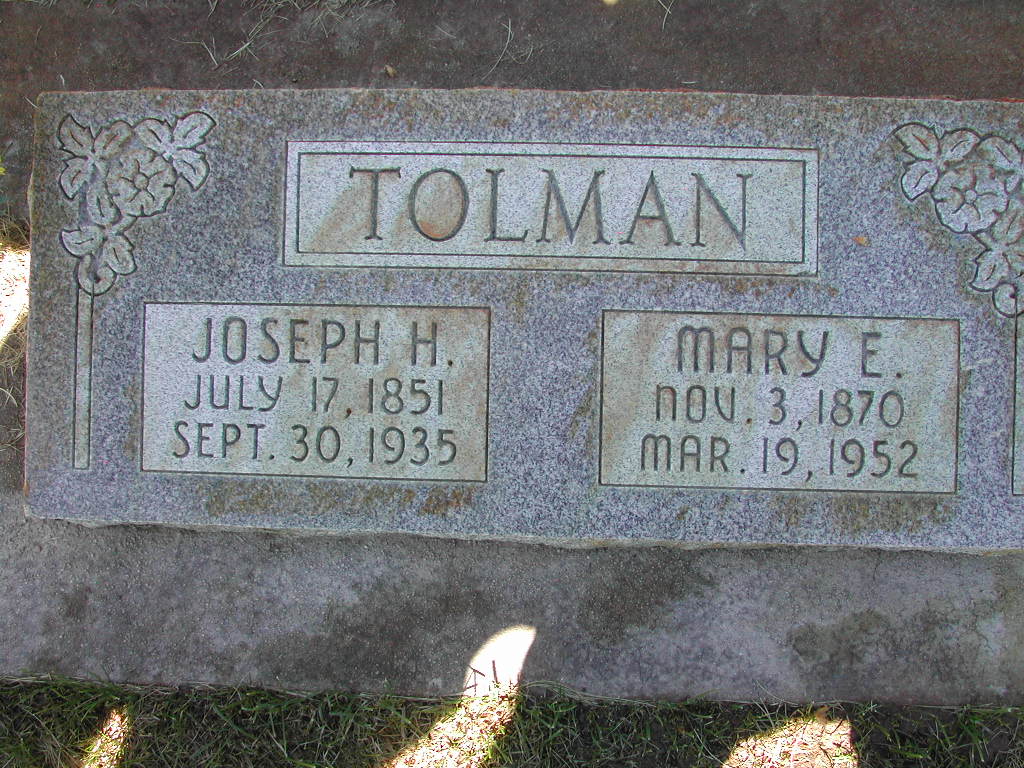
Mary Ellen Cahoon Gravestone
Gallery of photos off Mary Ellen and her husband Joseph Tolman (Password Required - Contact Michael Baird for password)